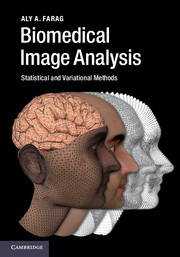Book contents
- Frontmatter
- Dedication
- Contents
- Preface
- Nomenclature
- 1 Overview of biomedical image analysis
- Part I Signals and systems, image formation, and image modality
- Part II Stochastic models
- Part III Computational geometry
- 8 Basics of topology and computational geometry
- 9 Geometric features extraction
- Part IV Variational approaches and level sets
- Part V Image analysis tools
- Index
- References
9 - Geometric features extraction
from Part III - Computational geometry
Published online by Cambridge University Press: 05 November 2014
- Frontmatter
- Dedication
- Contents
- Preface
- Nomenclature
- 1 Overview of biomedical image analysis
- Part I Signals and systems, image formation, and image modality
- Part II Stochastic models
- Part III Computational geometry
- 8 Basics of topology and computational geometry
- 9 Geometric features extraction
- Part IV Variational approaches and level sets
- Part V Image analysis tools
- Index
- References
Summary
Objects may be represented by various forms, but robust representations must maintain the features that describe the objects and enable analysis and decision making. As objects may not have a specific geometric description, these features may not be easy to specify. Likewise, known features about an object may be altered in the imaging process. Furthermore, if an object is to be compared with similar ones in a database, it is important that features involved in this comparison be robust (ideally invariant) to changes in scale, rotation, and translation. This chapter deals with feature definitions and characterization through feature descriptors. In the computer vision and image analysis literature, various approaches have been introduced to define, detect, and describe features. Local photometric and geometric features have proven to be very successful in applications such as object recognition, stereo matching, image retrieval, robot localization, video data mining, building panoramas, and recognition of object categories (e.g. [9.1]–[9.5]). This chapter will discuss global and local features, and how to extract corners, edges, contours or salient regions, which are among the common features used in image analysis algorithms. The chapter will describe feature detection and a number of efficient descriptors, including SIFT, ASIFT, and SURF. Good surveys of interest-point detectors and feature descriptors exist in the computer vision literature (e.g. [9.6],[9.7]).
Introduction
This section will provide basic definitions related to features and descriptors. The previous chapter discussed geometric and topological representations of objects. As much as possible, we will maintain the same terminologies and concepts.
A local feature is a point or pattern in an image that differs from its immediate neighborhood, and is associated with a change in an image property or a number of properties simultaneously.■
Information
- Type
- Chapter
- Information
- Biomedical Image AnalysisStatistical and Variational Methods, pp. 213 - 272Publisher: Cambridge University PressPrint publication year: 2014
References
Accessibility standard: Unknown
Why this information is here
This section outlines the accessibility features of this content - including support for screen readers, full keyboard navigation and high-contrast display options. This may not be relevant for you.Accessibility Information
- 1
- Cited by
